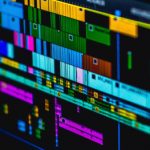 Sound plays a crucial role in enhancing the overall audiovisual experience in films, television shows, and other multimedia projects. Within the realm of sound production, there are two distinct yet interconnected processes: sound editing and sound design. While these terms are often used interchangeably, they refer to different aspects of sound manipulation and have unique roles in the creative process. In this blog post, we will explore the differences between sound editing and sound design, shedding light on their individual contributions to the final product.
Sound plays a crucial role in enhancing the overall audiovisual experience in films, television shows, and other multimedia projects. Within the realm of sound production, there are two distinct yet interconnected processes: sound editing and sound design. While these terms are often used interchangeably, they refer to different aspects of sound manipulation and have unique roles in the creative process. In this blog post, we will explore the differences between sound editing and sound design, shedding light on their individual contributions to the final product.
Defining Sound Editing:
Sound editing involves the selection and arrangement of existing sound elements to create a seamless and coherent audio experience. It focuses on organizing and manipulating recorded sounds from various sources to suit the visual narrative. Sound editors work with dialogue tracks, sound effects, and other prerecorded audio elements, ensuring that the sounds blend seamlessly with the visuals. They enhance the quality and continuity of the audio by adjusting levels, removing unwanted noise, synchronizing sound with visuals, and creating smooth transitions between scenes. Sound editing aims to improve the overall clarity and realism of the audio without drastically altering or adding new sounds to the existing material.
Understanding Sound Design:
While sound editing focuses on manipulating existing sounds, sound design involves the creation and integration of new and original sounds to enhance the storytelling and evoke specific emotional responses. Sound designers are responsible for conceptualizing and realizing unique and innovative soundscapes that complement the visuals and accentuate the narrative. They often work closely with directors, producers, and other creatives to understand the artistic vision and create sounds that bring the story to life. Sound design may include the creation of sound effects, ambient sounds, foley, musical elements, and other sonic components. It goes beyond editing and involves a more artistic and imaginative approach to sound manipulation.
Key Differences:
1. Basis:
The main difference between sound editing and sound design lies in their foundation. Sound editing is based on the manipulation and arrangement of existing sounds, focusing on enhancing the audio quality and continuity. On the other hand, sound design involves the creation of new sounds, using artistic techniques to evoke specific emotions and enhance the storytelling.
2. Realism vs. Imagination:
Sound editing is primarily concerned with realism. Its purpose is to create a seamless and believable audio experience that matches the visuals on the screen. The goal is to enhance the authenticity of the sounds without drawing too much attention to them. In contrast, sound design leans towards imagination, allowing for the creation of abstract and unconventional sounds that enhance the narrative and evoke specific emotions.
3. Collaboration:
Both sound editing and sound design require collaboration with other members of the creative team. However, sound editing often involves working closely with the film or video editor to ensure synchronization and coherence between sound and visuals. Sound designers, on the other hand, collaborate more closely with directors, producers, and other creatives to understand their vision and create unique soundscapes that align with it.
4. Timeframe:
Sound editing is generally done in the post-production stage, after the principal photography is completed. It focuses on refining and enhancing the existing audio material before the final mix. Sound design, on the other hand, can start at any stage, including pre-production. Sound designers may be involved in the pre-production process to gather specific sounds or brainstorm ideas before moving into post-production for further refinement.
Summary:
Sound editing and sound design are distinct yet interconnected processes within the realm of sound production. While sound editing focuses on manipulating existing sounds to enhance audio quality and continuity, sound design involves creating new sounds to enhance storytelling and evoke specific emotions. Understanding the differences between these two processes is crucial for appreciating the intricate work that goes into creating engaging and immersive audiovisual experiences. By utilizing the right balance of sound editing and sound design, filmmakers and multimedia creators can effectively capture the essence of their stories and engage audiences on a deeper level.
Need Audio Documentation Equipment in Seattle, WA?
Welcome to Efficiency, Inc.! Efficiency, Inc. is a woman-owned and -operated voice processing solutions company in Seattle that services the Pacific Northwest. We offer courtroom recording and transcription equipment and software. We also offer dictation solutions that are available for single-hand or hands-free operation. Our audio and video solutions can also help with court and interview room recordings. Since 1954, we have been providing courtroom equipment as well as voice processing solutions for a wide spectrum of businesses and organizations. Our products use the latest technologies and come with on-site or remote support, installation, and training — all provided by your Efficiency team. Call us today!
